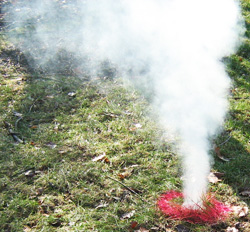 As homeowners, it is vital we maintain and repair our homes to ensure the structure will endure. Likewise, communities must be diligent about maintaining infrastructure because neglecting it will lead to costly and inconvenient repairs. Smoke testing is one of the best methods used to maintain a healthy sanitary sewer system. It should be completed during the warmest and driest time of the year when the groundwater is at its lowest and storm inlets are dry.
As homeowners, it is vital we maintain and repair our homes to ensure the structure will endure. Likewise, communities must be diligent about maintaining infrastructure because neglecting it will lead to costly and inconvenient repairs. Smoke testing is one of the best methods used to maintain a healthy sanitary sewer system. It should be completed during the warmest and driest time of the year when the groundwater is at its lowest and storm inlets are dry.Inflow and Infiltration Complications
Smoke testing is a cost-effective and quick way to identify inflow and infiltration (I/I) sources. Inflow and infiltration are terms used to describe the ways in which water enters the sanitary sewer system. Inflow is stormwater that enters the sanitary sewer system through a direct connection such as catch basins, sump pumps, curb inlets, yard drains, roof drains, and open cleanouts. Infiltration is groundwater that enters sanitary sewer pipes and manholes through unwanted cracks and joints. Water entering your sanitary sewer through I/I can be worrisome because of the negative impact on your system. If you do not address the I/I issues, you may experience some of the following complications:
- Large volumes of unnecessary water causing system overloading, which will reduce hydraulic efficiency and may cause surcharging/residential back-ups including flooded basements
- Unnecessary equipment use at lift stations
- Increased operating and water treatment expenses
- Increased collection system maintenance
- Regulatory fines and orders
How Does Smoke Testing Work?
To identify leaks in your sanitary sewer system, non-toxic smoke is blown through isolated pipe segments to observe both private and public property defects (i.e. pipe fractures and offset joints, connected downspouts, defective cleanouts, and storm inlets). Pressurized smoke will fill both the main and service lateral connections. Wherever smoke can get out, water can get in.
While the smoke is blowing, crews conduct a visual inspection to record the location of defects; each defect is marked with a flag or spray-painted and photographed for the owner. When smoke testing, records should include these features:
- Defect observation number
- Upstream and downstream manholes (or Segment ID)
- Property address
- Defect type (public vs. private)
- Smoke quantity
- Defect location via two points of reference
- Drainage area
- Recommendations for rehabilitation
Plugs can be used to isolate particular pipe segments and increase smoke pressure, maximizing defect identification.
Prior to smoke testing, we recommend you acquire system mapping, if available. Check your equipment’s oil levels, leaks in hoses, test plugs for leakage, and ensure air tank is working properly.
Homeowner and Public Coordination
Communication is important when smoke testing in residential areas to put homeowners at ease. Notify them 24 to 48 hours in advance through the distribution of flyers and door hangers. These notifications typically contain FAQs and instructions for the residents, which include pouring at least one gallon of water into unused drains to prevent smoke from entering the property. Inform local police and fire departments about the smoke testing to avoid unnecessary calls. Public coordination is crucial.
To minimize residential concerns, consider communicating the following:
Smoke testing sanitary sewers is one of the most cost-effective tools for locating unwanted sources of I/I and should be performed prior to moving forward with more expensive collection system evaluation techniques such as sanitary sewer cleaning and televising.
- Smoke from a roof vent pipe indicates a property is properly plumbed
- If the residence is not plumbed correctly, dangerous sewer gases could enter through fixtures
- Possible causes for smoke entering a building include:
- Defective vents, piping, and seals
- Dry or defective traps under sinks, showers, floor drains, etc. (fill traps prior to smoke testing with water or vegetable oil if the drain is rarely used)
- The liquid smoke is non-toxic, non-staining, non-flammable, safe for pets, and will dissipate within a few minutes
- If smoke does enter a building, inform residents to open doors and windows to ventilate the premises
Tags

